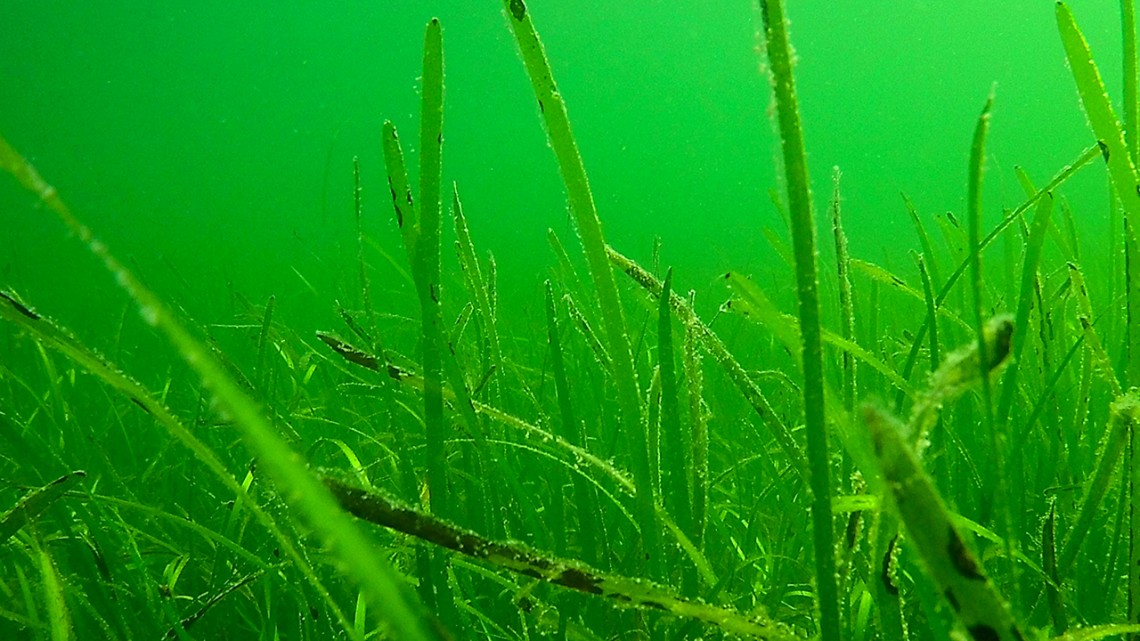
Lesions on eelgrass in an underwater meadow.
NSF grants $1.3M to Cornell, partners to hunt eelgrass disease
By Blaine Friedlander
To chase down a disease that threatens eelgrass – critical seaside meadows that undergird commercial fishing and promote coastal health – the National Science Foundation has awarded researchers from Cornell, the Smithsonian Institution, University of California, Davis and the University of Central Florida with a three-year $1.3 million grant.
By air, by sea and by terabyte on terra firma, the scientists will search for the pathogenic causes of eelgrass wasting disease on 36 sites along the Pacific Coast from Southern California to Alaska. When the disease strikes, eelgrass (Zostera marina) a type of seagrass, becomes infected with black-edged lesions, impeding photosynthesis – killing the grass and endangering coastal water health.
“The lesions eat away and kill the tissue, and then the whole blade can break off. The causative agent (Labyrinthula zosterae), is extremely infectious,” said co-principal investigator Drew Harvell, professor of ecology and evolutionary biology.
For the world’s ecosystems, seagrass is valuable, but it is perpetually threatened by pollution and climate change. It supplies habitat for salmon, crabs, trout and herring, filters nutrient pollution and protects the shore from erosion.
On this project, Harvell will join with co-principal investigator Carla Gomes, professor of computer science and the director of the Institute for Computational Sustainability, to develop a software application called Eelisa (pronounced eel-EYE-zah). After artificial intelligence training sessions, Eelisa will sort through thousands of seagrass blade images in minutes to expertly quantify lesions.
The researchers will apply artificial intelligence to problems in environmental sustainability, by using algorithms and machine learning to train a computer to recognize eelgrass blade lesions and correctly identify them and separate them from other causes, such as nicks, cuts or heat stress.
Eelisa is a potentially transformative tool for global monitoring of the seagrass threat, said Gomes, who is working with Brendan Rappazzo, M.Eng. ’18, a doctoral student in computer science, to develop the application.
“We are trying to accelerate the process of identifying lesions on the seagrass blades,” said Gomes. “We’d like to have a consistent application to identify healthy versus unhealthy tissue, with an expert level of performance or better. That is the big picture.”
Emmett Duffy, director of the Marine Global Earth Observatories at the Smithsonian Environmental Research Center, is the grant’s lead investigator. Tim Hawthorne, at the University of Central Florida, will deploy drones to provide high-resolution, sub-meter imagery of coastal seagrass beds.
Morgan Eisenlord, a Cornell doctoral student in the field of ecology and evolutionary biology, runs intertidal surveys in the seagrass meadows and is refining diagnostics with cultured strains of the pathogen. Cornell doctoral student Olivia Graham, also in ecology and evolutionary biology, leads the deeper water SCUBA surveys and lab experiments to test if resident herbivores can vector disease.
The project’s undergraduates have not been selected. The entire seagrass team will meet in November to plan for field sampling next summer.
Harvell said the research follows a large ocean heat wave responsible for the high levels of eelgrass wasting disease, which Cornell student interns, Graham and Eisenlord, have been documenting from the Puget Sound to Alaska.
“The combination of a heat-facilitated pathogen and record warming ocean events has been devastating eelgrass beds,” Harvell said. “And we think this disease is capable of reducing eelgrass meadows more. It’s an urgent priority to find better ways to manage disease in warming oceans.”
Media Contact
Get Cornell news delivered right to your inbox.
Subscribe
